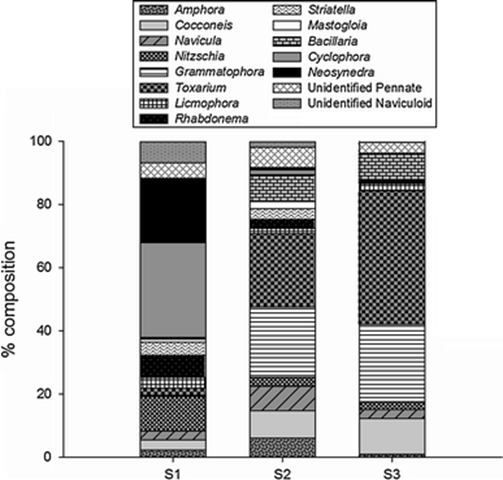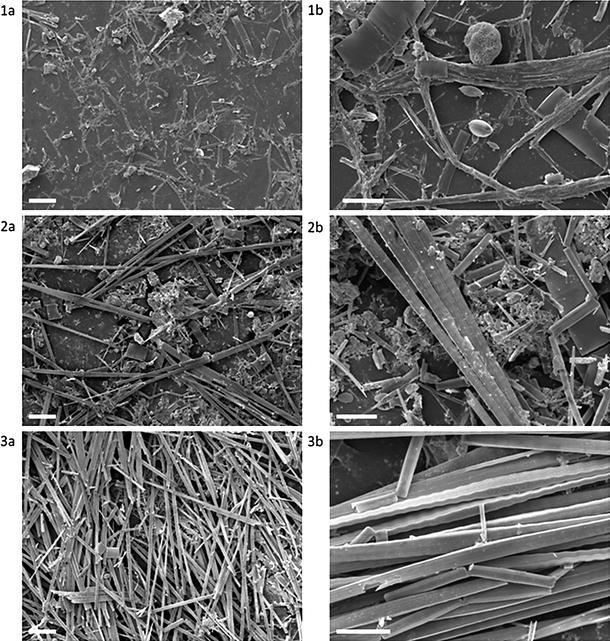Graph of the Day: Responses of Marine Benthic Microalgae to Elevated CO2
Relative composition of the periphytic diatom assemblages along the CO2 gradient, including all genera present over 1% and with all unidentified diatoms grouped as unidentified pennate or naviculoid. Between September 2009 and October 2010, mean surface seawater pH decreased with increasing proximity to CO2 vents (S1 = 8.18, S2 = 8.05, S3 = 7.49, n = 18) and was significantly different between all stations (Kruskal–Wallis test, H 2 = 34.499, P < 0.001). The pH at S1 fell within the normal range of coastal waters (IQ: 8.13–8.22) whilst stations exposed to high CO2 had a greater range in pH that increased with proximity to the main venting area (S2 IQ: 8.00–8.19, S3 IQ: 7.36–7.89, n = 18). A significant difference in diatom abundance (mean % cover on slides) was detected between stations (ANOVA, F (2,33) = 610.212, P < 0.001); greater values were recorded with increasing CO2 levels (Holm-Sidak pairwise comparisons, S3 > S2 > S1, P < 0.001) (Fig. 3). The highest abundances were found on slides at S3 (60 ± 1.11%), a sevenfold increase from S1 (8.5 ± 0.60%). There was no significant difference in the percentage cover of cyanobacteria in the periphtyic communities between stations (ANOVA, F (2,33) = 3.041, P = 0.061) that remained relatively low (<2%) across the gradient.
SEM images of slides colonised by periphytic diatoms at the three stations; S1 (1a, 1b), S2 (2a, 2b) and S3 (3a, 3b). Diatom colonisation increases with rising pCO2 concentrations along the gradient (1a, 2a, 3a). Changes in the community composition also occur with colonies of Grammatophora spp. and Toxarium undulatum dominating in S2 and S3 (2b, 3b) (Scale bars: 1a, 2a, 2b = 100 μm, 1b, 2b, 3b = 50 μm)
ABSTRACT: Increasing anthropogenic CO2 emissions to the atmosphere are causing a rise in pCO2 concentrations in the ocean surface and lowering pH. To predict the effects of these changes, we need to improve our understanding of the responses of marine primary producers since these drive biogeochemical cycles and profoundly affect the structure and function of benthic habitats. The effects of increasing CO2 levels on the colonisation of artificial substrata by microalgal assemblages (periphyton) were examined across a CO2 gradient off the volcanic island of Vulcano (NE Sicily). We show that periphyton communities altered significantly as CO2 concentrations increased. CO2 enrichment caused significant increases in chlorophyll a concentrations and in diatom abundance although we did not detect any changes in cyanobacteria. SEM analysis revealed major shifts in diatom assemblage composition as CO2 levels increased. The responses of benthic microalgae to rising anthropogenic CO2 emissions are likely to have significant ecological ramifications for coastal systems. […] Our findings indicate that periphytic diatoms exhibit a non-uniform response to CO2 enrichment; this is most likely due to taxon-specific differences in their sensitivity to CO2 concentrations and presumably due to their kinetics of carbon use. CO2-induced community shifts have also been observed in many other photoautotrophic assemblages (Tortell, et al., 2002, 2008; Fu, et al., 2007; Russell, et al., 2009; Trimborn, et al., 2009; Connell and Russell 2010; Porzio, et al., 2011) adding to evidence that increasing CO2 emissions are likely to lead to structural and functional changes in a wide variety of marine and coastal systems. […]
Responses of marine benthic microalgae to elevated CO2 via Ocean Acidification

